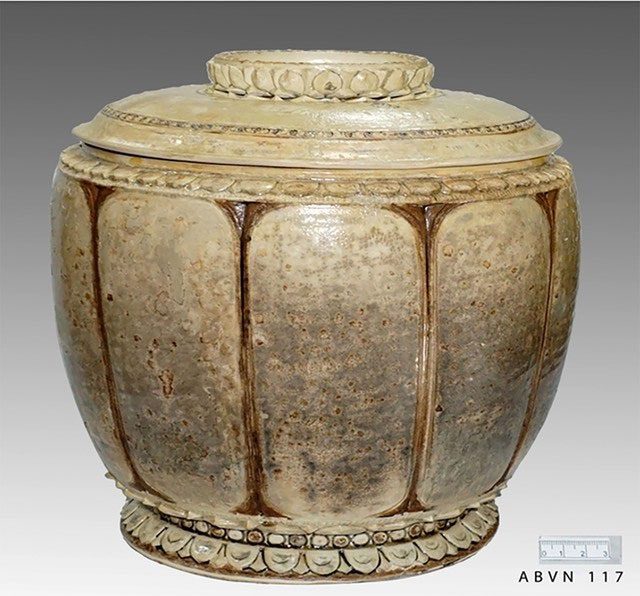Brown-glazed ceramic vase from the 11th and 12th centuries shaped like a lotus flower, identified as a reliquary box.
This national treasure was recognized by the Prime Minister in January and is currently part of Mr. Trần Đình Thăng’s collection in Hai Phong City.
Mr. Thăng stated that he has owned the ceramic vase since the 1980s, following advice from a Japanese collector. He asserts that the vase is a unique artifact, showcasing craftsmanship, shape, and patterns that reflect the cultural nuances of the dynasty, while also possessing intangible cultural heritage value.

The artifact has a mouth diameter of 22.7 cm and a base diameter of 18 cm. (Photo: Cultural Heritage Department).
The treasure is also known as Lý dynasty brown-glazed ceramic reliquary or reliquary box. The vase stands 25.5 cm tall and weighs 2.7 kg, consisting of two detachable parts: a lid and a body that fit together. The lid is flat and spherical, with a slightly flared mouth, topped with a knob designed as a blooming lotus with three layers of petals and round beads resembling white and brown pearls interspersed between two parallel raised lines. The shoulder features evenly carved lotus petals.
The body is cylindrical, with a curved surface, wider at the top and tapering at the bottom, divided into ten evenly spaced rectangular compartments that curve at the corners, resembling a lotus with ten petals. The base is designed resembling a lotus pedestal, resting on a round surface, with the bottom left unglazed for stability.
The vase is made from white clay and kaolin, covered with an off-white glaze and brown glaze. During production, artisans combined molding, shaping, and carving techniques to create the decorative patterns on a potter’s wheel, before firing it at temperatures around 1,200 degrees Celsius.
According to documents from the Cultural Heritage Department, the product has uniform maturity in both the clay body and glaze, with minimal warping or bubbling. The glaze color is ivory due to the clay not being thoroughly refined. The brown glaze was created from local mineral materials, ground into powder and mixed with several other additives including stone and iron oxide. When fired at high temperatures, it produces various shades of brown, such as coffee and chestnut.
The artifact’s documentation from the Cultural Heritage Department indicates that the brown-glazed vase not only possesses high artistic value but also served in Buddhist rituals during the Lý dynasty.
The combination of ivory and brown glazes, along with the lotus petal shapes, suggests that the vase dates back to the 11th-12th centuries and was collected within the territory of Vietnam. According to the National History Museum’s documentation, Buddhism was the predominant theme on brown-glazed ceramics from the Lý to Trần dynasties, with lotus flowers and their variations being prominently featured.
Furthermore, based on its shape and decorative motifs including lotus petals, small circles, and parallel straight lines on the vase, many researchers in archaeology, art, and Vietnamese cultural heritage have identified the artifact as belonging to the category of Buddhist ceremonial items of the dynasty, serving as a reliquary for relics, a spiritual embodiment for worship in stupas.
The Cultural Heritage Department emphasizes that the artifact reflects the local characteristics of the Vietnamese people, embodying the cultural and political essence of the Lý dynasty’s monarchical state when Buddhism became the state religion. The detail of the vase’s body divided into ten segments illustrates an ancient Eastern cultural concept: “Nine heavens, ten directions of Buddha.” This signifies that every space holds a Buddha. The treasure’s documentation cites Mahayana Buddhism: “Sentient beings, when their minds hold Buddha, will live in awareness and mindfulness supported by the Buddha, blessed to avoid suffering.”
Additionally, this vase is one of the exemplary representations of the development of Lý dynasty ceramic art, reflecting the ideological values, aesthetic standards of the era, as well as illustrating the religious life of the community. Scholars assert that only in a peaceful and developed society can artisans create outstanding products rich in cultural aesthetics through the nurturing influence of Buddhism.


















































